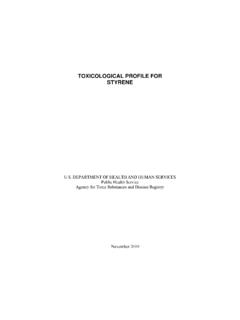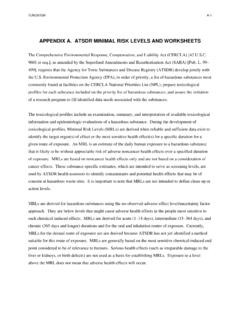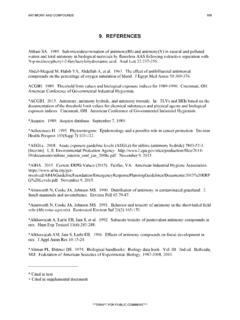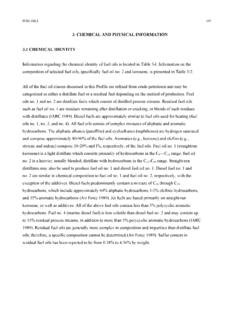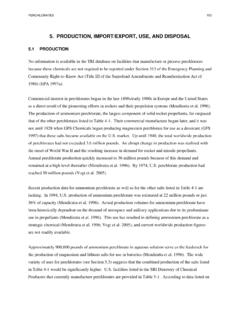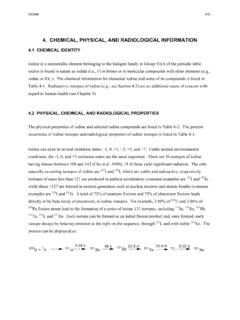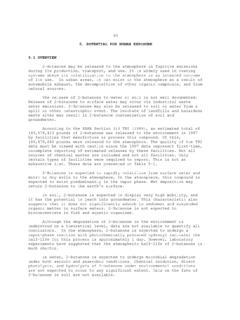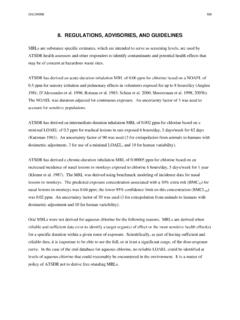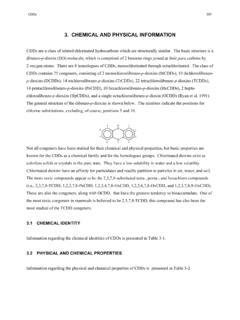Transcription of TOXICOLOGICAL PROFILE FOR JET FUELS JP-4 AND JP-7
1 TOXICOLOGICAL PROFILE FOR JET FUELS JP-4 AND JP-7 DEPARTMENT OF HEALTH AND HUMAN SERVICES Public Health Service Agency for Toxic Substances and Disease Registry June 1995 JET FUELS JP-4 AND JP-7 ii DISCLAIMER The use of company or product name(s) is for identification only and does not imply endorsement by the Agency for Toxic Substances and Disease Registry. JET FUELS JP-4 AND JP-7 iii UPDATE STATEMENT TOXICOLOGICAL profiles are revised and republished as necessary, but no less than once every three years. For information regarding the update status of previously released profiles contact ATSDR at: Agency for Toxic Substances and Disease Registry Division of Toxicology/Toxicology Information Branch 1600 Clifton Road NE, E-29 Atlanta, Georgia 30333 JET FUELS JP-4 AND JP-7 vii CONTRIBUTORS CHEMICAL MANAGER(S)/AUTHORS(S): Obaid Faroon, ATSDR, Division of Toxicology, Atlanta, GA Diane Mandell, Clement International Corp.
2 , Fairfax, VA Hernan Navarro, Research Triangle Institute, Research Triangle Park, NC THE PROFILE HAS UNDERGONE THE FOLLOWING ATSDR INTERNAL REVIEWS: 1. Green Border Review. Green Border review assures consistency with ATSDR policy. 2. Health Effects Review. The Health Effects Review Committee examines the health effects chapter of each PROFILE for consistency and accuracy in interpreting health effects and classifying end points. 3. Minimal Risk Level Review. The Minimal Risk Level Workgroup considers issues relevant to substance-specific minimal risk levels (MRLs), reviews the health effects database of each PROFILE , and makes recommendations for derivation of MRLs. 4. Quality Assurance Review. The Quality Assurance Branch assures that consistency across profiles is maintained, identifies any significant problems in format or content, and establishes that Guidance has been followed.
3 JET FUELS JP-4 AND JP-7 ix PEER REVIEW A peer review panel was assembled for JP-4 and JP-7. The panel consisted of the following members: 1. Dr. William Nick Norton, Professor, Biology Department, Southeastern Louisiana University, Hammond, Louisiana; 2. Dr. Laurence Martin Holland, Private Consultant, 215 Rio Bravo, Los Alamos, New Mexico; 3. Dr. Arthur Gregory, Private Consultant, Techto Enterprises, Sterling, Virginia; 4. Dr. Tim Borges, Technical Information Analyst, Oak Ridge National Laboratory, Oak Ridge, Tennessee; and 5. Dr. Bruce Jacobs, Environmental Health Engineering Services Manager, General Physics Corporation, Edgewood, Maryland. These experts collectively have knowledge of JP-4 s and JP-7 s physical and chemical properties, toxicokinetics, key health end points, mechanisms of action, human and animal exposure, and quantification of risk to humans.
4 All reviewers were selected in conformity with the conditions for peer review specified in Section 104(i)(13) of the Comprehensive Environmental Response, Compensation, and Liability Act, as amended. Scientists from the Agency for Toxic Substances and Disease Registry (ATSDR) have reviewed the peer reviewers comments and determined which comments will be included in the PROFILE . A listing of the peer reviewers comments not incorporated in the PROFILE , with a brief explanation of the rationale for their exclusion, exists as part of the administrative record for this compound. A list of databases reviewed and a list of unpublished documents cited are also included in the administrative record. The citation of the peer review panel should not be understood to imply its approval of the PROFILE s final content.
5 The responsibility for the content of this PROFILE lies with the ATSDR. 1 JET FUELS JP-4 AND JP-7 1. PUBLIC HEALTH STATEMENT This statement was prepared to give you information about jet FUELS JP-4 and JP-7 and to emphasize the human health effects that may result from exposure to them. The Environmental Protection Agency (EPA) has identified 1,397 hazardous waste sites as the most serious in the nation. These sites make up the National Priorities List (NPL) and are the sites targeted for long-term federal clean-up activities. JP-4 has been found in at least 4 of these sites. JP-7 has not been found in any NPL site. However, the number of NPL sites evaluated for JP-4 and JP-7 is not known. As EPA evaluates more sites, the number of sites at which JP-4 and JP-7 are found may increase.
6 This information is important for you to know because JP-4 and JP-7 may cause harmful health effects and because these sites are potential or actual sources of human exposure to JP-4 and JP-7. When a chemical is released from a large area, such as an industrial plant, or from a container, such as a drum or bottle, it enters the environment as a chemical emission. This emission, which is also called a release, does not always lead to exposure. You can be exposed to a chemical only when you come into contact with the chemical. You may be exposed to it in the environment by breathing, eating, or drinking substances containing the chemical or from skin contact with it. If you are exposed to a hazardous chemical such as JP-4 or JP-7, several factors will determine whether harmful health effects will occur and what the type and severity of those health effects will be.
7 These factors include the dose (how much), the duration (how long), the route or pathway by which you are exposed (breathing, eating, drinking, or skin contact), the other chemicals to which you are exposed, and your individual characteristics such as age, sex, nutritional status, family traits, lifestyle, and state of health. WHAT ARE JET FUELS JP-4 AND JP-7? JP-4 and JP-7 (jet propellant-4 and jet propellant-7) are substances that are used by the Air Force as aircraft FUELS . They are also called jet fuel-4 and jet fuel-7. JP-4 is a colorless 2 JET FUELS JP-4 AND JP-7 1. PUBLIC HEALTH STATEMENT to straw-colored liquid. It smells like gasoline and/or kerosene. JP-7 is also a liquid, usually colorless. It smells like kerosene. Both JP-4 and JP-7 are flammable.
8 JP-4 can be made by refining either crude petroleum oil or shale oil. JP-7 is made by refining kerosene, a product of refined crude petroleum. Both JP-4 and JP-7 are blends of other chemicals made according to standards specified by the Air Force for each fuel. Both JP-4 and JP-7 are liquids at room temperature, but they can also change into vapor. In this PROFILE , JP-4 and JP-7 are discussed together. See chapter 3 for more information on the chemical and physical properties of JP-4 and JP-7. More information on the production and use of JP-4 and JP-7 is found in chapter 4. WHAT HAPPENS TO JET FUELS JP-4 AND JP-7 WHEN THEY ENTER THE ENVIRONMENT? We have information about what happens to JP-4 or its components in the environment. Although JP-7 is similar, there is not much information about what happens to it in the environment.
9 JP-4 enters the environment when it spills or leaks into water or soil. It can enter the air during manufacturing, by evaporation of spills, and when it is discarded or jettisoned from jets during flight. JP-4 is a mixture of many chemicals. After it is released, the mixture spreads out in the atmosphere, and the component chemicals behave differently than they did in the liquid mixture. The behavior of each component in the environment depends on its individual chemical and physical properties. When JP-4 enters the air from flying jets as unburned fuel, some of the constituent chemicals fall back to the earth and land on water or soil. Other chemicals stay in the air and may change to different compounds when they react with light or other chemicals. Most of the chemicals in JP-4 evaporate when JP-4 spills into water.
10 Some of the chemicals that do not evaporate as fast may dissolve in the water. If the water is very rough when the spill occurs, more JP-4 components will dissolve in the water. The chemicals that dissolve in the water are broken down further by microorganisms or become attached to the solid materials, called sediment, in the water. The chemicals that bind to this sediment may settle to the bottom of the water and stay there for a JET FUELS JP-4 AND JP-7 3 1. PUBLIC HEALTH STATEMENT long time. When JP-4 spills or leaks to soil, some of the chemicals evaporate, but many of them are broken down by microorganisms. Some of them may also stick to the soil. Components that do not break down easily and components that stick to soil particles may stay in the soil for a long time.
